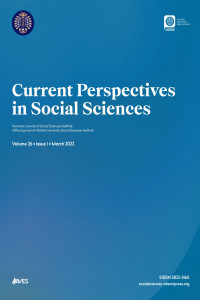The Invisibility of Male Witches in British Culture from the Early Modern Period to Modern Day
In popular literary works, films, and television series, the impression is given that all people
accused, tried, and executed for witchcraft in early modern Europe between 1563 and 1736, as
required by the Witchcraft Act, were women. As a result of this false impression, the existence of
men accused of witchcraft and executed is ignored. In the historical texts, it is seen that there is
no gender discrimination among the people accused of witchcraft. The pacts they make with evil
spirits are more important than the gender of those accused of witchcraft. Although witchcraft
accusations were not sex-specific in that era, studies later focusing on that period have created
the idea that men were excluded from the trials. Especially feminist readings focusing on women’s
executions have created the false impression that, due to gender roles in that period, women
suffered from male patriarchy. It is an undeniable fact that the vast majority of people executed
were women and that men were in the minority group; however, dismissing the male executions
altogether does not serve the purpose of condemning the trials. The fact that all the prosecutors
in the British judicial system were men in early modern period and that women were not able to
practice law plays an important role and has reshaped reality because while men were perceived
as prosecutors of women’s executions, women were merely the ones accused and oppressed.
Anahtar Kelimeler:
British culture, early modern period, witches, witchcraft law
___
- Apps, L., & Gow, A. C. (2003). Gender at stake: Male witches in early modern Europe. Manchester University Press
- Blomquist, L. T. (2011). Rehabilitating the witch: The literary representation of the witch from the “Malleus Maleficarum” to “Les Enfants Du Sabbat”.
- Ph.D., Rice University. Retrieved from https://www.proquest.com/dissertations-theses/rehabilitating-witch-literary-representation/docview/ 1034285664/se-2?accountid=8403 (3521287).
- Durrant, J., & Bailey, M. D. (2012). Historical dictionary of witchcraft (2nd ed.). Scarecrow Press.
- Goodare, J. (1998). Women and the witch-hunt in Scotland. Social History, 23(3), 288–308. [CrossRef]
- Goodare, J. (2005). The Scottish witchcraft act. Church History, 74(1), 39–67. [CrossRef]
- Goodare, J. (2009). Men and the witch-hunt in Scotland. In A. Rowlands (Ed.). Witchcraft and masculinities in early modern Europe (pp. 149–170). Springer.
- History.com Editors. (2022). Halloween 2022. A&E Television Networks.
- Howsam, L. (1989). “Sound-minded women”: Eliza Orme and the study and practice of law in Late-Victorian England. Atlantis, 15(1), 44–55.
- Hufton, O. (1983). Women in history: Early modern Europe. Past and Present, 101(1), 125–141. [CrossRef]
- Hutton, R. (2018). Witches and cunning folk in British literature 1800–1940. Preternature: Critical and Historical Studies on the Preternatural, 7(1), 27–49. [CrossRef]
- Kent, E. J. (2005). Masculinity and male witches in Old and New England, 1593–1680. History Workshop Journal, 60(1), 69–92. [CrossRef]
- Levack, B. P. (1980). The great Scottish witch hunt of 1661–1662. Journal of British Studies, 20(1), 90–108. [CrossRef]
- Levack, B. P. (2006). The witch-hunt in early modern Europe (3rd ed). Pearson Education Limited.
- MacFarlane, A. (1999). Witchcraft in Tudor and Stuart England (2nd ed). Routledge.
- Madej-Stang, A. (2015). Which face of witch: Self-representations of women as witches in works of contemporary British women writers. Cambridge Scholars Publisher
- Martin, L., & Miller, J. (2008). Some findings from the survey of Scottish witchcraft. In J. Goodare, L. Martin & J. Miller (Eds.), Witchcraft and belief in early modern Scotland (pp. 51–70). Palgrave Macmillan UK. [CrossRef]
- Millar, C.-R. (2021). Diabolical men: Reintegrating male witches into English witchcraft. Seventeenth Century, 36(5), 693–713. [CrossRef]
- Monter, W. (1997). Toads and Eucharists: The male witches of Normandy, 1564–1660. French Historical Studies, 20(4), 563–595. [CrossRef]
- Morgan, S. (2019). Perspectives on male witches in early modern England University of Bristol (United Kingdom)]. PQDT.
- Rowlands, A. (2009). Not ‘the usual suspects’? Male witches, witchcraft, and masculinities in early modern Europe. In A. Rowlands (Ed.), Witchcraft and masculinities in early modern Europe (pp. 1–30). Springer.
- Santino, J. (1983). Halloween in America: Contemporary customs and performances. Western Folklore, 42(1), 1–20. [CrossRef]
- Schulte, R. (2009). Man as witch: Male witches in central Europe. Palgrave Macmillan UK.
- Shakespeare, W. (2020). Macbeth. Türkiye İş Bankası Kültür Yayınları.
- Başlangıç: 2003
- Yayıncı: Atatürk Üniversitesi
Sayıdaki Diğer Makaleler
Hükümet Sistemleri Üzerinden Mukayeseli Bir Analiz (Parlamenter Sistem–Başkanlık Sistemi)
Muhammet Yasin ELİTOK, Fatih DEĞİRMENCİ
İnci DURSUN, Ebru TÜMER KABADAYI, Elif ARALIK
McCarthy’s Roots in Tradition and Perception of Nature in The Road
Fârâbî’de Felsefe ve Geometri İlgisi
The Invisibility of Male Witches in British Culture from the Early Modern Period to Modern Day
21’inci Yüzyılda Savaş: Savaşın Dönüşümü ve Yeni Aktörlerin Tipolojisi
Cinematic Narration in Altın Çocuk and James Bond Differences, Similarities and Geographies
Mert GÜRER, Harun Mustafa TÖLE
Seçilmiş Makroekonomik Göstergelerin Çevresel Bozulma Üzerindeki Etkisi: BRICS-T Ülkeleri
